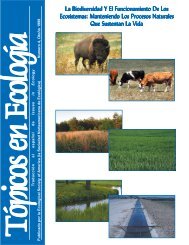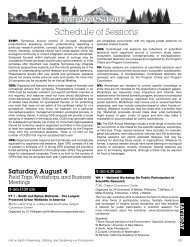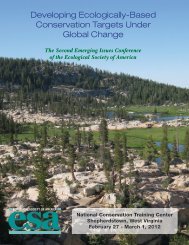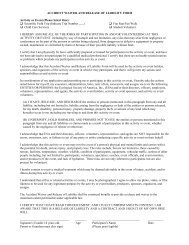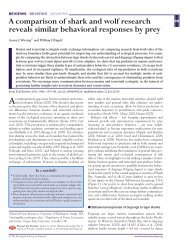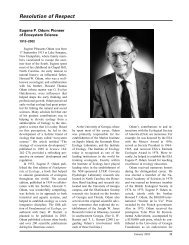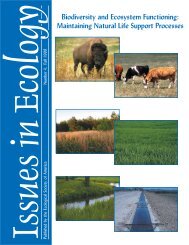Printed Program (PDF) - Ecological Society of America
Printed Program (PDF) - Ecological Society of America
Printed Program (PDF) - Ecological Society of America
Create successful ePaper yourself
Turn your PDF publications into a flip-book with our unique Google optimized e-Paper software.
Farrar 2 , N van Vinh Chau 4 , HR van Doorn 2 , J Cardosa 5<br />
and BT Grenfell 1 , (1)Princeton University, (2)Oxford<br />
University Clinical Research Unit, (3)Penn State<br />
University, (4)Hospital for Tropical Diseases, (5)Sentinext<br />
Therapeutics. Disentangling the role <strong>of</strong> herd immunity<br />
versus novel strain introduction in outbreaks <strong>of</strong> an<br />
infectious disease.<br />
2:10 PM COS 155-3 Moore, SM 1 , RJ Eisen 2 and A Monaghan 1 ,<br />
(1)National Center for Atmospheric Research, (2)<br />
Centers for Disease Control and Prevention. Improving<br />
disease prediction and modeling through the use <strong>of</strong><br />
meteorological ensembles: Rainfall and human plague<br />
cases in Uganda.<br />
2:30 PM COS 155-4 Perkins, TA 1 , DL Smith 2 and T Scott 3 , (1)<br />
Fogarty International Center, NIH, (2)Johns Hopkins<br />
Bloomberg School <strong>of</strong> Public Health, (3)University <strong>of</strong><br />
California, Davis. Sources <strong>of</strong> heterogeneity and scales <strong>of</strong><br />
transmission <strong>of</strong> mosquito-borne pathogens.<br />
2:50 PM COS 155-5 Mollik, MAH, Practical Academy on Wise<br />
Education and Research Foundation. Children ailments<br />
treated with medicinal plants: Results from a crosssectional<br />
survey within Meherpur district, Bangladesh.<br />
3:10 PM Break<br />
3:20 PM COS 155-6 Ingwell, LL and NA Bosque-Pérez, University<br />
<strong>of</strong> Idaho. The presence <strong>of</strong> Barley/Cereal yellow dwarf<br />
viruses among grass hosts in habitat fragments within an<br />
agricultural matrix in the Pacific Northwest.<br />
3:40 PM COS 155-7 Kramer, AM, JT Pulliam, SP Maher and<br />
JM Drake, University <strong>of</strong> Georgia. Simplifying networks:<br />
Spread <strong>of</strong> White-nose syndrome in North <strong>America</strong>.<br />
4:00 PM COS 155-8 Civitello, DJ 1 , SE Pearsall 1 , MA Duffy 2 and<br />
SR Hall 1 , (1)Indiana University, (2)Georgia Institute <strong>of</strong><br />
Technology. Host foraging ecology drives transmission<br />
<strong>of</strong> a fungal parasite <strong>of</strong> Daphnia.<br />
4:20 PM COS 155-9 Penczykowski, RM 1 , JL Hite 2 , MS Shocket 2 ,<br />
SR Hall 2 and MA Duffy 1 , (1)Georgia Institute <strong>of</strong><br />
Technology, (2)Indiana University. Nutrient enrichment<br />
and altered habitat structure increase disease in the<br />
plankton.<br />
4:40 PM COS 155-10 Buck, JC, KI Scholz and AR<br />
Blaustein, Oregon State University. The effects <strong>of</strong><br />
community structure on host-pathogen dynamics <strong>of</strong><br />
Batrachochytrium dendrobatidis.<br />
COS 156 - Ecosystem Services Assessment III<br />
D139, Oregon Convention Center<br />
1:30 PM COS 156-1 Dewsbury, BM, M Bhat and JW Fourqurean,<br />
Florida International University. An ‘optimal’ solution for<br />
the valuation <strong>of</strong> seagrass ecosystems.<br />
1:50 PM COS 156-2 Liss, KN, EM Bennett and A Gonzalez, McGill<br />
University. Does configuration matter? Connecting<br />
landscape management to ecosystem service provision.<br />
2:10 PM COS 156-3 Railsback, SF and MD Johnson, Humboldt<br />
State University. Foraging theory for individual-based<br />
models <strong>of</strong> pest control by birds: Tests in a model <strong>of</strong><br />
c<strong>of</strong>fee borer suppression by warblers in Jamaica.<br />
2:30 PM COS 156-4 Walsh, SM 1 , J Brenner 1 , A Guerry 2 and JL<br />
Molnar 1 , (1)The Nature Conservancy, (2)The Natural<br />
Capital Project & Stanford University. Coastal natural<br />
hazard mitigation: Opportunities for businesses to lead<br />
investments in local public goods.<br />
2:50 PM COS 156-5 Liere, H 1 , BP Werling 2 , TD Meehan 1 , DA<br />
Landis 2 and C Gratton 1 , (1)University <strong>of</strong> Wisconsin, (2)<br />
Michigan State University. Measuring yield benefits <strong>of</strong><br />
biocontrol services in bioenergy landscapes.<br />
3:10 PM Break<br />
Life on Earth: Preserving, Utilizing, and Sustaining our Ecosystems<br />
3:20 PM COS 156-6 Bernhardt, JR 1 , SA Wood 2 , A Guerry 3 , M<br />
Ruckelshaus 4 , J T<strong>of</strong>t 5 , KK Arkema 5 and G Guannel 5 , (1)<br />
University <strong>of</strong> British Columbia, (2)The Natural Capital<br />
Project, Stanford University, (3)The Natural Capital<br />
Project & Stanford University, (4)Natural Capital Project,<br />
(5)Stanford University. Counting what matters: Modeling<br />
ecosystem services to support marine spatial planning in<br />
coastal British Columbia.<br />
3:40 PM COS 156-7 Swain, H 1 , EH Boughton 1 , PJ Bohlen 2 , JE<br />
Fauth 2 , DG Jenkins 2 , GA Kiker 3 , P Quintana-Ascencio 2<br />
and S Shukla 3 , (1)Archbold Biological Station, (2)<br />
University <strong>of</strong> Central Florida, (3)University <strong>of</strong> Florida.<br />
Assessing trade-<strong>of</strong>fs among ecosystem services in<br />
a payment-for-water services program on Florida<br />
ranchlands.<br />
4:00 PM COS 156-8 Olmsted, P 1 , JC Ingram 2 and S Naeem 3 , (1)<br />
University <strong>of</strong> British Columbia, (2)Wildlife Conservation<br />
<strong>Society</strong>, (3)Columbia University. The science behind<br />
payments for ecosystem services programs: A global<br />
survey.<br />
COS 157 - Ecosystem Stability And Resilience I<br />
E141, Oregon Convention Center<br />
1:30 PM COS 157-1 Muthukrishnan, R1 , JO Lloyd-Smith2 and P<br />
Fong1 , (1)UCLA, (2)University <strong>of</strong> California, Los Angeles.<br />
Empirical evidence from and simulations <strong>of</strong> a tropical<br />
coral reef show positive feedbacks can produce alternate<br />
community states.<br />
1:50 PM COS 157-2 Donohue, I, A Dubois and J García Molinos,<br />
Trinity College Dublin. Resource stability regulates<br />
ecosystem multifunctionality.<br />
2:10 PM COS 157-3 Venail, PA and BJ Cardinale, University <strong>of</strong><br />
Michigan. Phylogenetic diversity affects the temporal<br />
stability <strong>of</strong> communities by altering species’ functioning<br />
and competitive interactions. .<br />
2:30 PM COS 157-4 Creissen, HE1 , TH Jorgensen2 and JKM<br />
Brown1 , (1)John Innes Centre, (2)University <strong>of</strong> East<br />
Anglia. Diversity awareness: Using Arabidopsis as a<br />
model for crop varietal mixtures.<br />
2:50 PM COS 157-5 Holmgren, M1 , M Hirota2 , EH van Nes2 and M<br />
Scheffer2 , (1)University <strong>of</strong> Wageningen, (2)Wageningen<br />
University. Inferring resilience <strong>of</strong> forest ecosystems from<br />
satellite data.<br />
3:10 PM Break<br />
3:20 PM COS 157-6 Thompson, PL, B Rayfield and A Gonzalez,<br />
McGill University. The spatial insurance hypothesis in<br />
spatially explicit networks.<br />
3:40 PM COS 157-7 Hammond, MP and J Kolasa, McMaster<br />
University. Spatial variation, synchrony, and loss <strong>of</strong><br />
stability in ecosystem variables.<br />
4:00 PM COS 157-8 Seekell, DA1 , SR Carpenter2 , TJ Cline3 and ML Pace1 , (1)University <strong>of</strong> Virginia, (2)University<br />
<strong>of</strong> Wisconsin - Madison, (3)University <strong>of</strong> Wisconsin.<br />
Conditional heteroskedasticity warns <strong>of</strong> impending<br />
regime shift in whole-ecosystem experiment.<br />
4:20 PM COS 157-9 Pace, ML1 , SR Carpenter2 , J Kurtzweil2 and RA Johnson1 , (1)University <strong>of</strong> Virginia, (2)University<br />
<strong>of</strong> Wisconsin. Zooplankton provide early warning <strong>of</strong> a<br />
regime shift in a whole lake manipulation.<br />
4:40 PM COS 157-10 Dai, L1 , D Vorselen2 , K Korolev1 and<br />
J Gore1 , (1)Massachusetts Institute <strong>of</strong> Technology, (2)<br />
VU University. Critical slowing down provides advance<br />
warning <strong>of</strong> population collapse .<br />
COS 158 - Estuarine<br />
E142, Oregon Convention Center<br />
1:30 pm-5 pm<br />
157<br />
THURSDAY



